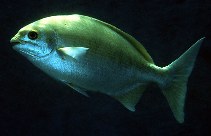| Family: |
Kyphosidae (Sea chubs) |
| Max. size: |
75 cm TL (male/unsexed); max.weight: 1,850.0 g |
| Environment: |
reef-associated; marine; depth range - 2 m, oceanodromous |
| Distribution: |
Indo-Pacific: Antitropical; Red Sea, South Africa, western and eastern Australia, Lord Howe and Rapa islands, southern Japan and Ryukyu Islands. Records for countries in the tropical zone needs further confirmation. |
| Diagnosis: |
Dorsal spines (total): 11-11; Dorsal soft rays (total): 11-12; Anal spines: 3-3; Anal soft rays: 10-12; Vertebrae: 16-16. This species is distinguished by the following characters: terminal mouth is almost in an oblique angle; presence of scales in the interorbital region; D XI,11-12 rays; A III,10-12; gill rakers externally on first arch 4-7 + 13-17; pectoral fin is relatively short, 13.6-21.3 %SL); anal-fin base relatively long (18.1-24.8 %SL; lateral line scales 61-76, with pores 51-60; longitudinal scales 54-67; cheek scales 9-16; vertebrae 10 + 16; low number of pterygiophores, dorsal 20-21 and anal 12. Colour of body variable brownish to silvery with dusky unpaired fins when fresh; soft parts of the dorsal and anal fins appear dusky and have black or darker edges; dark edges on dorsal, anal and caudal fins appear pronounced in more adult individuals, but may also vary from habitat to habitat; cheek and area below eye usually with a white or silvery streak (Ref. 95491). |
| Biology: |
Found around exposed seaward reefs of isolated high islands such as the northernmost Mariana and Bonin Is. Feeds on Sargassum and Turbinaria algae. Valued as a food fish, but not in Hawaii (Ref. 3921). |
| IUCN Red List Status: |
Least Concern (LC); Date assessed: 07 July 2014 Ref. (130435)
|
| Threat to humans: |
harmless |
Source and more info: www.fishbase.org. For personal, classroom, and other internal use only. Not for publication.
